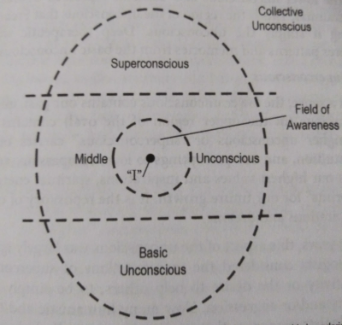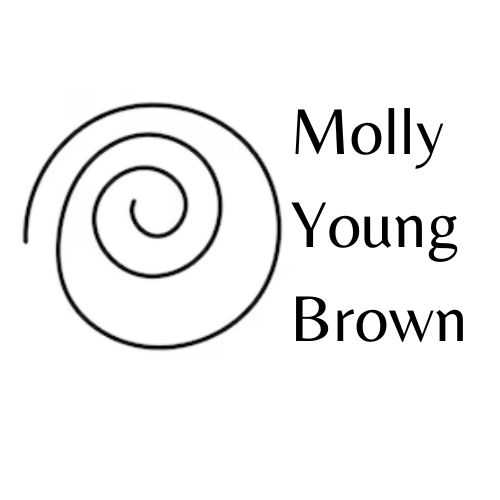Self-Regulation & the Egg Diagram
by Molly Young Brown, 2006
In September, 2006, I had the privilege of presenting workshops in Sweden and Finland to teachers and advanced students of psychosynthesis—a two-day workshop in Stockholm and two three-day workshops on Nagu Island in the archipelago off the southwest coast of Finland. I considered it a privilege because the people attending participated so fully—immersing themselves in the exercises, asking keen questions, and offering their own ideas to the dialogue that ensued. In the second Nagu Island workshop, as we explored the relationship between systems thinking and psychosynthesis, we discovered we could use the classic “Egg Diagram” of psychosynthesis to map a key concept of systems thinking: “self-regulation” through “negative feedback.” I found this new model very exciting and would like to share it here.
The Egg/Oval Diagram

I’ll begin with a brief explanation of the psychosynthesis “egg” or oval diagram, which charts the fields of consciousness in the individual. Roberto Assagioli, the founder of psychosynthesis, proposed that the unconscious has three levels:
1) the lower or basic unconscious, corresponding to Freud’s unconscious arena of fundamental drives and elementary psychological activities that direct the life of the body, as well as repressed desires and traumas; 2) the middle unconscious as a neutral area of recently forgotten and easily recalled experience, similar to what Freud called the preconscious; and 3) the higher unconscious or superconscious, wherein lies our creativity, intuition, promptings to love, compassion, and service, our highest values and inspirations, our spiritual energies and emerging growth patterns. These three levels are represented by horizontal dotted lines dividing the egg in three more or less equal parts. Outside the Egg lies the collective unconscious, also divided into these three levels.
In the midst of the middle section (denoting the middle unconscious) is a circle representing the immediate field of awareness at any given time, with “I” at the center. The lines between these areas are dotted, indicating their permeability either way. The boundaries of the Egg are permeable, too, as material from all levels of the collective unconscious moves into our unconscious and we send out our thoughts and feelings into the collective.
Awareness, acceptance, and integration of material from the higher unconscious are as vital to our personal development as is processing material from the lower unconscious; in fact, the “repression of the sublime” can have as severe consequences as the repression of sexuality and aggression from the lower unconscious. Rather than being merely a victim of desires, conditioned responses, and unconscious drives, each of us has the capacity to be the orchestrator of his or her own life—one who can bring into actualization the tremendous potentials stored in the superconscious (both collective and individual), and at the same time, direct and integrate the energies and patterns of the lower unconscious.
Some Basics of Systems Thinking
Next, a little background on the relevant concepts of systems thinking. To self-regulate, systems respond in ways that counteract any deviation from their established patterns of interaction. Systems thinkers call this interchange between system and environment “negative feedback” because it reduces deviation. Such responses change the system’s relationship to the environment to restore conditions to a tolerable range. When someone becomes overheated, for example, negative feedback loops within the body stimulate perspiration, the evaporation of which helps cool the body to within an optimal temperature range, reducing the deviation from this norm. Negative feedback regulates every aspect of systemic functioning; it essentially defines and delimits every system, in complex and interpenetrating webs.
Sometimes a response that formerly reduced deviation fails to do so under the new conditions; the deviation goes unchecked and even amplifies, becomes greater. Systems theorists call this process “positive feedback”. If this amplification continues long enough, it becomes “runaway positive feedback” which eventually—or quickly—destroys the system. For the system to survive, it must quickly establish new response patterns adapted to the new demands of the environment (the larger system) and supported by negative feedback once again.
This process is called adaptation, self-organization, or learning. It’s difficult to give examples of positive feedback loops in living systems, because they are usually very short-lived. Some systems thinkers resist associating learning with positive feedback for this reason. They would say that learning is essentially the creation of new negative feedback loops. And indeed it is. It may be that positive feedback only delivers the “kick” that moves a system into new patterns of response.
In living systems, positive and negative feedback operate together. If a system only maintained itself according to established patterns (as most mechanical systems do), it would be unable to adapt to changing conditions in the environment and eventually wear out, or blow up, or collapse. This is why we humans must constantly tinker with our machines to keep them functioning. If a system only experienced positive feedback, it would have no “integrity,” it would maintain no pattern and instantly cease to exist as a coherent whole. So while adapting to changing conditions when incited by positive feedback, all living systems maintain themselves through negative feedback, and reduce deviation around new response patterns as soon as possible.
Living systems have internal “codes” that determine how each system responds to its environment through negative feedback—these are the “established patterns of interaction” mentioned above. But what are these “codes” and where do they come from? At the most basic level, they are genetic—prompting plants to grow towards the light, birds to migrate, and humans to shiver when cold. In the Nagu workshop, we proposed that these hard-wired codes—or instincts— belong in the lower or basic unconscious on the Egg Diagram.
Living systems also learn new patterns of response to their environment through positive feedback. Much of this learning occurs unconsciously, through conditioning, and all too often occurs as the result of trauma. Such conditioned responses may prove dysfunctional in other life circumstances. A child who has been abused grows up fearful of displeasing anyone, and thus succumbs to more abuse from her spouse. This conditioned response operates as an unconscious “code” and prevents her from standing up for herself. The Nagu group also assigned these conditioned responses to the lower or basic unconscious on the Egg Diagram.
As social beings, however, humans’ codes of response are not limited to genetic instincts and conditioning. Families, tribes, communities, and nations establish laws and rules to govern collective behavior. People also have unwritten norms that modulate everything from dress, to table manners, to ways of greeting one another—a huge array of social interactions. The Nagu workshop group assigned these to the “middle unconscious” on the Egg Diagram, because most people can readily bring these rules and norms to consciousness.
What codes would reside in the higher unconscious or superconscious? The Nagu group thought that morals and values would come from that level. A person’s values are often unconscious, although a person might experience a sense of discomfort or even anger when faced with a situation that violates those values. “Values clarification” attempts to bring values into consciousness so they can be more readily used in decision-making.
In making these distinctions among levels of the unconscious and the codes that guide negative feedback loops, I do not mean to imply that codes from the higher unconscious are “better” than conditioned responses or social norms. In many situations, these are essential to our survival and well-being. When our physical bodies are threatened with real and immediate danger, we need the instantaneous response of instinct and conditioned response to protect ourselves. When working within a community, we are far more effective if we keep our behaviors within reasonable norms for that group of people—and it’s useful if that process can be largely unconscious, so we can focus on the task at hand. If I have a so-called “higher value” of freedom and try to impose that on my driving behavior, I am likely to end up with a ticket at best. Many laws, rules, and norms do help us to live together, at least at our current level of social development.
At the same time, many other laws, rules, and norms clearly perpetuate dysfunctional patterns of relationship. This is where the “higher” codes of values, morals, intuition, and inner guidance come into play—when our norms and rules no longer work, or are actually creating problems for all concerned. (And in our interconnected universe, anything that creates a problem for one living system—or person—creates a problem for all.) In addition to the feedback loops within the individual or the society, we are collectively involved in negative, self-regulatory, feedback loops within the larger system of which our society is a part.
The larger ecological system attempts to maintain itself according to its established patterns by bringing an errant sub-system into line. Perhaps the larger system is the source of inner guidance or intuition. It seems to me that when we go deeply within, we connect more completely with the world around us—not so much the human world as the whole enchilada: the human world and the natural world that contains the human. We become part of the internal feedback loops of the whole ecosystem. We might experience the negative, self-regulatory feedback circuits of the larger system as “positive” (deviation-amplifying) at the individual level, because individual and social codes must change in order for the larger system to find balance.
Gregory Bateson (1967) speaks to this dynamic in one of my all-time favorite quotations: “Mere purposive rationality unaided by such phenomena as art, religion, dream and the like, is necessarily pathogenic and destructive of life.” This is because “life depends upon interlocking circuits of contingency, while consciousness can see only such short arcs of such circuits as human purpose may direct” (p.146). The “short arcs” may be our individual patterns of response (negative feedback loops) that do not take into account the larger interlocking circuits of contingency that make up the web of life on Earth. What I am suggesting is that our “higher unconscious” codes may actually arise from the interconnected web of life, from the collective unconscious of life itself.
So when we are working with issues such as global climate change, poverty, or social justice, we need to call upon something beyond even our personal values. Missionaries have done terrible damage to indigenous cultures throughout history by failing to do this. We need to open ourselves to guidance from the most encompassing meta-system we can access to avoid doing more harm than good.
I believe that we are all deeply attuned to the whole as systems within a larger system; we receive and send information constantly along the strands of the living web that holds us all. If we can quiet the noise of our daily lives, if we can suspend for a short time our conditioned responses and unconscious adherence to social norms, we can better receive that guidance. Moment to moment as circumstances change and evolve, feedback from the larger system will help us respond powerfully and harmoniously, in ways that benefit not only ourselves, but also the larger whole.
References
- Bateson, G. (1967). Style, grace and information in primitive art. Steps to an ecology of mind, New York: Ballentine.
- Brown, M. Y. (2009) Growing Whole: Self-Realization for the Great Turning. Mt. Shasta CA: Psychosynthesis Press.
- Brown, M. Y. (2004). Unfolding Self: The practice of psychosynthesis. New York: Helios/Allworth.
- Macy, J. & Brown, M. (2014). Coming back to life: The Updated Guide to the Work That Reconnects. Gabriola Island, BC: New Society.
